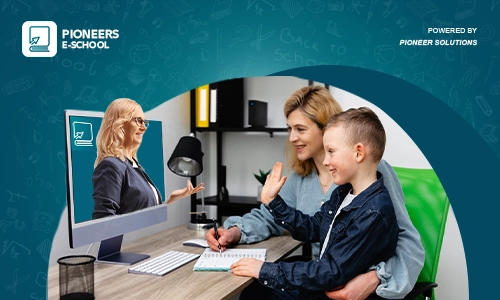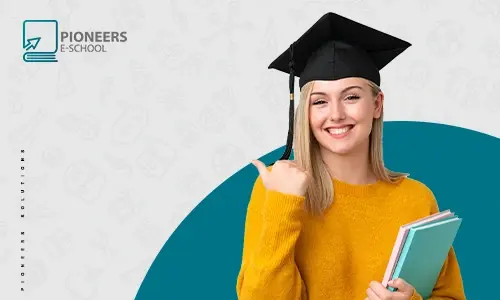Technology has evolved significantly in recent decades, providing us with a unique opportunity to transform and improve the education system in your educational institution. One of the most prominent technological advancements in the field of education is the concept of smart learning, which utilizes technology to enhance the learning process and improve student outcomes.
In this article, we will clarify the concept of smart learning, its benefits, the tools of smart learning and their functions, and the factors for the success of smart learning strategies in schools.
What is Smart Learning?
Smart learning is a learning approach that relies on the use of technology and artificial intelligence to enhance the education process and improve learning effectiveness. It aims to provide personalized and customized learning experiences for each student, focusing on meeting their individual needs and enhancing their abilities and talents.
In the smart learning model, data is collected and analyzed to understand students' preferences and learning patterns, and to provide appropriate educational content. Technological tools such as computers, tablets, and educational applications are used as supportive tools to the core education system, enabling students to easily access and interact with information in an interactive manner.
By employing smart learning techniques, self-learning systems are developed that learn and adapt based on students' responses, providing immediate guidance and feedback. These techniques can offer diverse and integrated educational content, such as educational videos, simulations, educational games, and interactive assessment tests.
What is the Difference Between Traditional Learning and Smart Learning?
The following table reflects some of the key differences between traditional learning and smart learning:
|
Traditional Learning |
Smart Learning |
|
Passive learning, where students receive information |
Active learning, where students actively engage with content |
|
One-size-fits-all approach to education |
Personalized and customized learning experiences |
|
Limited access to resources and information |
Easy access to diverse learning resources and interactive content |
|
Limited feedback and assessment opportunities |
Immediate feedback and adaptive assessment methods |
|
Teacher-centered approach |
Student-centered approach |
|
Limited individual support |
Individualized support based on students' needs |
|
Limited use of technology |
Integration of technology and artificial intelligence for enhanced learning |
By implementing smart learning strategies, we can revolutionize the education system and empower students with the skills and knowledge needed for success in the digital age. It opens up new possibilities for personalized, engaging, and effective learning experiences, leading to improved academic achievements and student satisfaction.
Advantages of Smart Learning
Smart learning has several advantages, including:
- Encouraging student engagement:
One of the key advantages of smart learning is the stimulation of student engagement. By using technology and interactive tools, a learning environment is created that actively encourages students to participate and interact with educational materials.
Smart learning provides interactive experiences that motivate students to engage actively. Educational games, simulations, and interactive tools can be used to capture students' attention and encourage them to participate and interact with the educational materials in innovative and exciting ways.
- Identifying students' strengths and weaknesses:
Smart learning helps in identifying students' strengths and weaknesses through the use of technology and data analysis. Smart learning can provide immediate assessment of students' performance. By collecting and analyzing available data on students' performance, such as test answers and participation in educational activities, immediate and accurate feedback can be provided. This helps learners understand their understanding of concepts and their ability to apply them.
By analyzing available data on students' performance, their strengths and weaknesses in specific areas can be identified. Students' progress can be monitored, and patterns of their performance can be analyzed to determine the skills they excel in and the skills they need to develop more effectively.
- Accurate performance evaluation:
Smart learning utilizes data analysis techniques to understand and evaluate students' performance. Data related to students' interaction with educational materials, completed tasks, and provided answers are collected. This data is analyzed to estimate the level of achievement of the student and understand their strengths and weaknesses in different subjects.
Smart learning can provide personalized guidance to students based on their performance analysis. The system can identify the concepts that need reinforcement and provide appropriate advice and strategies for improvement.
- Designing More Engaging Learning Models
Smart design involves using advanced interactive techniques such as virtual reality, augmented reality, and interactive educational games. These technologies allow students to actively participate and interact with the educational content, enhancing focus and active engagement.
Personalization is an essential part of smart learning model design. The smart system uses available data to understand the individual needs and requirements of students, providing appropriate educational content for each student based on their level, interests, and individual capabilities.
- Technologically Rich Environment
Smart learning provides an educational environment with advanced technology that provides easy and instant access to diverse learning resources. Students can benefit from the internet, software, and educational applications to access rich and diverse educational content with just an internet connection.
Smart learning includes the use of innovative educational tools such as educational robots, tablets, and interactive simulations. These tools enable students to experience effective and interactive learning, enhancing their understanding and developing their skills in innovative and inspiring ways.
Smart Learning Tools:
Smart learning tools encompass a variety of technologies and tools that enhance the learning process and improve students' experience. Here are some common tools for smart learning:
- Artificial Intelligence (AI): AI is used to develop intelligent learning systems capable of analyzing data, understanding student behavior, and providing relevant guidance. AI works to enhance customization, assessment, and provide personalized learning experiences.
- E-Learning Applications: E-learning applications include software and educational platforms that provide diverse educational content in a digital format. These applications can include educational videos, interactive activities, instant assessments, and discussion forums.
- Virtual Reality and Augmented Reality: Virtual reality and augmented reality technologies allow for realistic and interactive educational experiences. Students can explore 3D educational content and interact with it using smart glasses or mobile devices.
- Educational Robots: Educational robots enable students to interact with robotics technology and explore concepts such as programming and artificial intelligence. Students can experience building and programming robots and solving problems through interaction with these tools.
Factors for the success of smart learning strategy:
- Strong vision and leadership: The success of a smart learning strategy requires a clear vision from school leaders and educational officials regarding the importance and value of smart learning. They should have a strong commitment to educational technology and continuous improvement.
- Effective planning and implementation: A detailed strategic plan should be developed to implement smart learning in the school. This includes setting goals and desired outcomes, as well as allocating necessary resources. The plan should be executed systematically and in an organized manner, with monitoring and evaluation of its progress.
- Teacher training: Training teachers on using educational technology and implementing smart learning strategies is crucial. Providing training opportunities, workshops, and ongoing support for teachers is essential for developing their technological and instructional skills.
- Provision of technological infrastructure: Smart learning requires a strong and appropriate technological infrastructure in the school. This includes providing suitable devices such as computers, wireless networks, and high-speed internet, as well as necessary educational applications and software.
- Monitoring and performance evaluation: Monitoring and evaluating the performance of the smart learning strategy is important to measure its impact and effectiveness. Evaluation measures and data analysis can be used to assess progress and identify areas that need improvement and adjustment in the school's performance.
Requirements for Implementing Smart Learning Strategy
Implementing a smart learning strategy requires the following requirements:
- Technological Infrastructure: A strong and suitable technological infrastructure should be available in schools. This includes having computers or tablets for students, high-speed internet connection, and a robust wireless network. Additionally, appropriate educational software and applications should be provided to support smart learning.
- Teacher Training: Implementing a smart learning strategy requires training teachers on using educational technology and applying smart learning strategies. Continuous training opportunities and workshops should be provided to enhance teachers' technical and pedagogical skills and their understanding of how to integrate technology in the classroom.
- Smart Educational Resources: Smart and diverse educational resources that support smart learning should be provided. These resources may include interactive educational software, multimedia materials, simulations, and smart applications that help students explore concepts interactively and personally.
- Administrative Support and Leadership: School administration and higher-level leadership should support the smart learning strategy and have a clear vision and strong support for it. Leaders need to allocate necessary resources, provide technical support and guidance to teachers and students, and ensure the successful implementation of the strategy.
- Student Support and Active Participation: Support and guidance should be provided to students in using educational technology and fully benefiting from the strategy. Active and interactive student participation in educational processes should be encouraged, and personalized support should be provided to meet their needs and enhance their academic achievement.
Read also:
10 classroom management skills every teacher should know
In conclusion, we can say that the smart learning strategy is a key factor in improving the learning process and enhancing students' experience in classrooms. By using educational technology and implementing smart learning strategies, a rich learning environment can be created that fosters interaction, encouragement, and enables students to develop their skills and enhance their understanding of concepts.
For the smart learning strategy to be successful, it requires a strong technological infrastructure, teacher training in technology use and smart learning strategies, the provision of smart educational resources, administrative support and leadership, data analysis and monitoring of implementation, individual support for students, creating a suitable learning environment, and fostering communication and institutional partnerships.
By meeting these requirements, the maximum benefit of smart learning can be achieved, leading to improved learning outcomes and students' experience.
Related Articles

2024-12-25
Mohamed Abdelsalam
How School Management Systems Improve Parent-Teacher Collaboratio
Effective communication between parents and teachers is the cornerstone of a child’s academic success. Yet, traditional methods like parent-teac...

2024-08-01
Mohamed Abdelsalam
Successfully closing the school year using Pioneers E-School
As the end of the school year approaches, private schools face many challenges in closing the school year and preparing for the new year. This process...

2023-07-17
Mohamed Abdelsalam
Top 10 ideas for developing and improving schools management
School management has a crucial role in achieving improving student performance and developing the educational process. Developing school management i...





